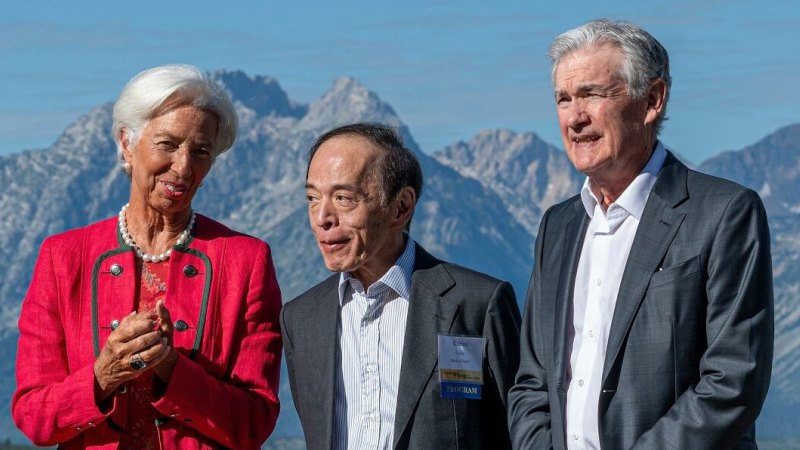
Dancing in the dark: The world’s central bankers don’t know what to do with interest rates
August 28, 2023Save articles for later
Add articles to your saved list and come back to them any time.
Jerome Powell expressed it colourfully when he told the annual Jackson Hole conference of central bankers, economists and other policymakers that the US Federal Reserve Board was “navigating by the stars under cloudy skies.”
It summed up the mood of the meeting in Wyoming that concluded at the weekend. Central bankers are unsure whether they’ve done enough, or not enough, to shunt inflation rates on a path towards their desired targets of around two per cent.
Jerome Powell, Bank of Japan governor Kazuo Ueda, and European Central Bank president Christine Lagarde at Jackson Hole.Credit: Bloomberg
The Fed chairman provided no insight into whether he thought the Fed’s 5.25 percentage points of rate rises in less than 18 months had conquered the worst inflationary outbreak in decades, leaving financial market participants in the dark as to whether US rates have peaked or whether they face at least one more rate rise before the end of the year.
The uncertainty shown by the speakers at the conference is not just about the conventional question that arise at the tail end of an economic cycle, where the lagging effects of rate increases make it likely that the central bankers will, with hindsight, be seen to have done too much and caused unnecessary economic harm.
The European Central Bank’s president, Christine Lagarde, encapsulated those broader uncertainties with her comment that “there is no pre-existing playbook for the situation we are facing today.”
Essentially, what she was referring to was a view that the world has changed quite fundamentally since the pandemic and the war in Ukraine, introducing some novel unknowns to the already unscientific task of setting monetary policies.
There have been changes to labour markets, which are, as she said, historically tight in advanced economies. The pandemic accelerated digitisation and vastly expanded remote working even as generative artificial intelligence has taken off, with its potential to both destroy jobs and create new ones.
The energy markets, particularly but not exclusively those in Europe, have been changed by both the continuing response to climate change, the war in Ukraine and the decline in investment in US shale oil and gas.
The tensions between Russia and China and the West, the fragmentation of the global economy into competing blocs and the rise in what is effectively protectionism as economies respond to both the new geopolitics and the experience of the pandemic are another source of structural change. Supply chains that have been exposed as fragile and over-exposed to a more assertive China are being rapidly reshaped.
What the Fed does or doesn’t do as it enter the final phase of this particular fight with inflation will have a big impact on the value of bonds, stocks and currencies and, of course, on the broader US economy.Credit: AP
Whether it is de-globalisation or a more limited restructuring of supply chains, if global supply, including labour, becomes less dynamic and economies become more insular and more concerned about security than competitiveness there will be an impact on prices and therefore inflation rates.
According to Lagarde, the response to climate change and the re-shoring and friend-shoring of supply chains are likely to lead to new supply constraints and could see a phase of heavy investment over a relatively short time horizon; one largely insensitive to business cycles.
She sees the changes of the past three years as likely to generate more shocks from the supply side of economies that will set the stage for larger relative price shocks than seen before the pandemic.
“If we face both higher investment needs and greater supply constraints, we are likely to see stronger price pressures in markets like commodities — especially for metals and minerals that are crucial for green technologies – and relative prices will also need to adjust to ensure that resources are reallocated towards growing sectors and away from shrinking ones.”
Lagarde’s conclusion is that central bankers will need to be more flexible in their analyses of economic conditions and not as reliant on models based on historical data. There will be a need for new models that capture the complexity the bankers are being confronted with in the new environment.
Most of the issues Lagarde touched on are long term and structural and will require central banks to incorporate a range of new influences into their thinking and decision-making. In the near term, of course, they still have to deal with the current state of their economies.
For the Fed that means grappling with the implications of an economy that, despite the eleven rate rises since March last year, is still growing solidly with historically low unemployment, robust consumer spending and a buoyant sharemarket.
Powell, knowing that the Fed can’t be far off the point where the rate rises hurt highly indebted consumers to the point where growth slows and unemployment starts rising, said the Fed would proceed “carefully.”
‘There is no pre-existing playbook for the situation we are facing today.’
The markets took that to mean there would be no additional increases at next month’s meeting of the Fed’s Open Market Committee but that there could be one at the November or December meeting.
What the Fed does, or doesn’t do, next matters for financial markets. Real (after inflation) bond yields are now positive and at levels not seen since 2009.
So far that hasn’t affected a sharemarket that, while about 4 per cent off its peak last month, is still more than 15 per cent higher than where it started this year.
The bond market’s investors, confronted by the wall of supply that looms as the US Treasury raises the $2.8 trillion it says it will tap markets for in the December half, are convinced market yields will continue to rise.
The modest sell-off by equity investors over the past month suggests they, too, are nervous about a market trading at nearly 19 times projected earnings compared with its historical average of about 16.5 times. (As interest rates rise the net present value of future cash flows and therefore valuations of companies fall).
In the near term, therefore, what the Fed does or doesn’t do as it enter the final phase of this particular fight with inflation will have a big impact on the value of bonds, stocks and currencies and, of course, on the broader US economy.
Longer term, however, it and its peers may have to think about how they respond to what could be regarded as a lengthy transition from the old economic order to the new and the complicated impacts that will have on growth, employment and prices.
That’s a very different and more daunting challenge than the already formidable uncertainties central bankers have grappled with in the past and are grappling with today.
The Business Briefing newsletter delivers major stories, exclusive coverage and expert opinion. Sign up to get it every weekday morning.
Most Viewed in Business
From our partners
Source: Read Full Article




